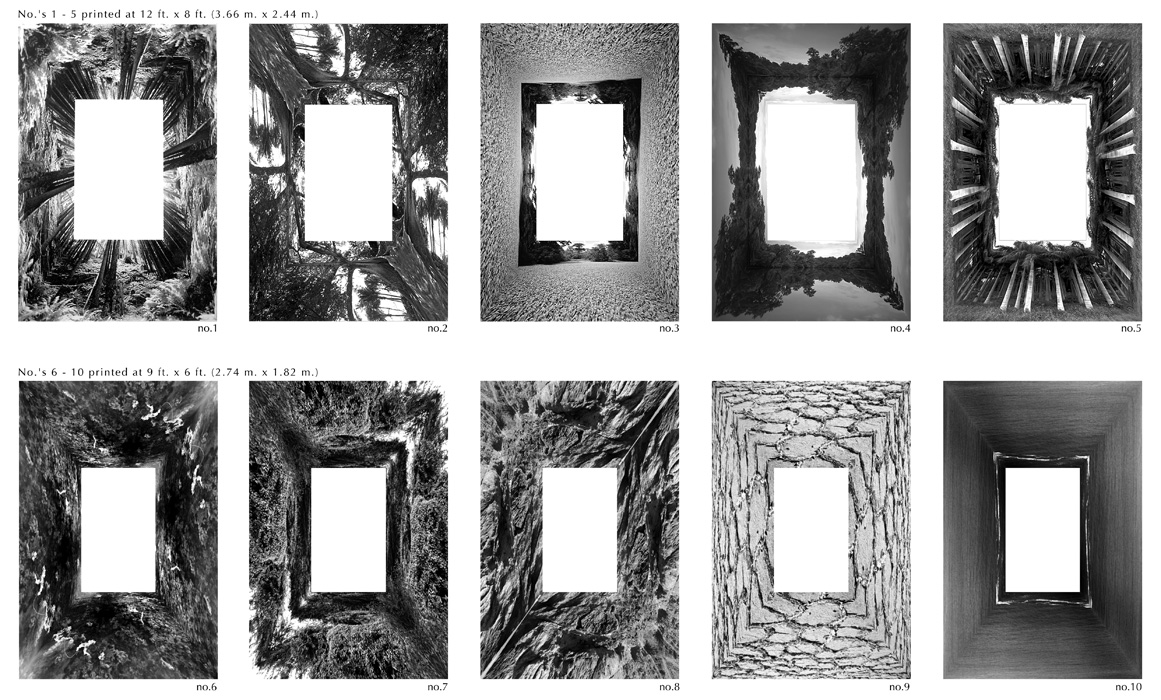The works from in series are digitally altered photographic images derived from the contemporary natural and meta-natural landscapes. The original photographic image is compressed to fit into each of four sides of a ‘frame’ surrounding an open void in the center of the work. This central negative space is physically absent. The proportions of the void are similar to that of a generic window.
Landscape Projection (for an Unknown Window) No 1, derived from images of a redwood grove in northwestern California, was first exhibited in the solo exhibition, "Dialogues with Nature," at the Lance Fung Gallery, New York, NY in 1998. No's 2-5 of the series were developed using images of the Florida landscape for the solo exhibition, The Rising Sea, Images and Constructions from South Florida and Other Selected Works, Museum of Contemporary Art, Lake Worth, FL., 1998-99. The Landscape Projections.. extend conceptual issues of nature in dialogue with architectural structure considered by other photographic works of the same time period, including: Spruce, 1998, Manhattan/Franciscan
Formation, 1998, Slump (Orchard)
I and II, 1998 and Gradient (Biscayne
Giant), 1998. This formative group of installations use their scale, image and configuration as abstract interior ‘earth works’ that formally engage architectural space to create tension and dialogue with the space within which they are installed. The Landscape Projections expand this concept into a theoretical dimension by suggesting an ‘unknown’ window in a conceptual building. The "window's" structure is at once a metaphysical one, a void in the center, and an organic one, a compressed photographic image framing the void. This altered organic landscape refers to a vitalist interpretation of architecture as an extension of nature, geologic building materials as remnants of a living earth: lava flows, recumbent folding, fossiliferous assemblages, metamorphic laminations and intrusions…
|
A parallel, historical inspiration for this group of photographic works can be found in the Baroque era and its interest in the unification of natural structures, systems and images with the formal concerns of architecture. The Landscape Projections.., with their reiterant, rectilinear structure and central void have a particular relationship to the Enlightenment's preoccupation with optics and perception and the subsequent interpretation of these sciences in formal landscape gardens such as at Versailles and Vaux-le-Vicomte as discussed by Allen Weiss in Mirrors of Infinity(1) with the sense that both natural and construction landscapes, framed and delimited, are a rigorous and complex form of an extended architecture. Conversely, architecture as referred to above, both as a geographic and geologic formation, may also be seen as a form of landscape, anticipating a series of later works engaging issues of anthroturbation(2).
Other works of this period, such as Holocene Terrace, and Holocene Passage, installed in the exhibitions, "Morphology of Change," at the Lance Fung Gallery in 1999 and "Intervening the Space: Revisiting Gordon Matta-Clark and Holocene Passage by John Roloff," at the Arcivio Emily Harvey, Venice, Italy in 2002, respectively, have resonance with ideas initiated in the Landscape Projections (for an Unknown Window) series. No's. 6-10 of the Landscape Projection.. series, were developed and shown as part of the solo exhibition, "Original Depositional Environment," Gallery Paule Anglim, San Francisco, CA, 2002.
(1) Allen S. Weiss, Mirrors of Infinity, Princeton Architectural Press, 1995
(2) Anthroturbation, or "human disturbance," a term developed in conversation with the geophysicist, Paul Spudich.
|
